Chinese ceramics
_imperial_blue_and_white_vase%2C_from_The_Metropolitan_Museum_of_Art._%E6%98%8E%E5%AE%A3%E5%BE%B7_%E6%99%AF%E5%BE%B7%E9%8E%AE%E7%AA%AF%E9%9D%92%E8%8A%B1%E8%B2%AB%E8%80%B3%E7%93%B6%2C_%E7%BA%BD%E7%BA%A6%E5%A4%A7%E9%83%BD%E5%8D%9A%E7%89%A9%E9%A6%86_.jpg)
Chinese ceramics show a continuous development since pre-dynastic times and are one of the most significant forms of Chinese art and ceramics globally. The first pottery was made during the Palaeolithic era. Chinese ceramics range from construction materials such as bricks and tiles, to hand-built pottery vessels fired in bonfires or kilns, to the sophisticated Chinese porcelain wares made for the imperial court and for export. Porcelain is so identified with China that it is still called "china" in everyday English usage.
Most later Chinese ceramics, even of the finest quality, were made on an industrial scale, thus few names of individual potters were recorded. Many of the most important kiln workshops were owned by or reserved for the Emperor, and large quantities of ceramics were exported as diplomatic gifts or for trade from an early date, initially to East Asia and the Islamic world, and then from around the 16th century to Europe. Chinese ceramics have had an enormous influence on other ceramic traditions in these areas.
Increasingly over their long history, Chinese ceramics can be classified between those made for the imperial court, either to use or distribute, those made for a discriminating Chinese market, and those for popular Chinese markets or for export. Some types of wares were also made only or mainly for special uses such as burial in tombs, or for use on altars.
Terminology and categories
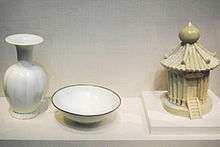
The earliest Chinese pottery was earthenware, which continued in production for utilitarian uses throughout Chinese history, but was increasingly less used for fine wares. Stoneware, fired at higher temperatures, and naturally impervious to water, was developed very early and continued to be used for fine pottery in many areas at most periods; the tea bowls in Jian ware and Jizhou ware made during the Song dynasty are examples.
Porcelain, on a Western definition, is "a collective term comprising all ceramic ware that is white and translucent, no matter what ingredients are used to make it or to what use it is put".[1] The Chinese tradition recognizes two primary categories of ceramics, high-fired [cí 瓷] and low-fired [táo 陶],[2] so doing without stoneware, which in Chinese tradition is mostly grouped with (and translated as) porcelain. Terms such as "porcellaneous" or "near-porcelain" may be used for stonewares with porcelain-like characteristics.[3] The Erya defined porcelain [cí 瓷] as "fine, compact pottery" [táo 陶].[4]
Chinese pottery can also classified as being either northern or southern. China comprises two separate and geologically different land masses, brought together by the action of continental drift and forming a junction that lies between the Yellow and Yangtze rivers, sometimes known as the Nanshan-Qinling divide. The contrasting geology of the north and south led to differences in the raw materials available for making ceramics; in particular the north lacks petunse or "porcelain stone", needed for porcelain on the strict definition. Ware-types can be from very widespread kiln-sites in either north or south China, but the two can nearly always be distinguished, and influences across this divide may affect shape and decoration, but will be based on very different clay bodies, with fundamental effects. The kiln types were also different, and in the north the fuel was usually coal, as opposed to wood in the south, which often affects the wares. Southern materials have high silica, low alumina and high potassium oxide, the reverse of northern materials in each case. The northern materials are often very suitable for stoneware, while in the south there are also areas highly suitable for porcelain.[5]
Materials
Chinese porcelain is mainly made by a combination of the following materials:
- Kaolin – essential ingredient composed largely of the clay mineral kaolinite.
- Porcelain stone – decomposed micaceous or feldspar rocks, historically also known as petunse.
- Feldspar
- Quartz[6]
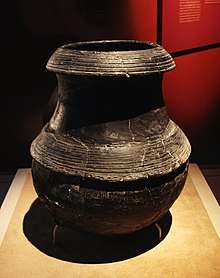
Technical developments
In the context of Chinese ceramics, the term porcelain lacks a universally accepted definition (see above). This in turn has led to confusion about when the first Chinese porcelain was made. Claims have been made for the late Eastern Han dynasty (100–200 AD), the Three Kingdoms period (220–280 AD), the Six Dynasties period (220–589 AD), and the Tang dynasty (618–906 AD).
Kiln technology has always been a key factor in the development of Chinese pottery. The Chinese developed effective kilns capable of firing at around 1,000 °C before 2000 BC. These were updraft kilns, often built below ground. Two main types of kiln were developed by about 200 AD and remained in use until modern times. These are the dragon kiln of hilly southern China, usually fuelled by wood, long and thin and running up a slope, and the horseshoe-shaped mantou kiln of the north Chinese plains, smaller and more compact. Both could reliably produce the temperatures of up to 1300 °C or more needed for porcelain. In the late Ming, the egg-shaped kiln or zhenyao was developed at Jingdezhen, but mainly used there. This was something of a compromise between the other types, and offered locations in the firing chamber with a range of firing conditions.[7]
History
Important specific types of pottery, many coming from more than one period, are dealt with individually in sections lower down.
Early wares

Pottery dating from 20,000 years ago was found at the Xianrendong Cave site, in Jiangxi province,[8][9] making it among the earliest pottery yet found. Another reported find is from 17,000–18,000 years ago in the Yuchanyan Cave in southern China.[10]
By the Middle and Late Neolithic (about 5000 to 1500 BCE) most of the larger archaeological cultures in China were settled farmers, who produced a variety of attractive and often large vessels, often boldly painted, or decorated by cutting or impressing. Decoration is abstract or stylized animals – fish are a speciality at the river settlement of Banpo. The distinctive Majiayao painted pottery, with orange bodies and black paint, is characterised by fine paste textures, thin walls, and polished surfaces; the almost complete lack of defects in excavated pots suggests a high level of quality control during production.[11] The Majiayao and other phases of the Yangshao culture are well-represented in Western museums; by the Banshan phase purple was used in slip-painting alongside black.[12] During the 4th millennium the potter's wheel seems to scholars of Chinese ceramics to have been a Chinese invention,[13] though several regions to the West also claim the honour. Previously coil-forming was used for large vessels.[14]
Finds of vessels are mostly in burials, and sometimes hold the remains. By 4100–2600 BCE in the Dawenkou culture shapes later familiar from Chinese ritual bronzes begin to appear. One exceptional ritual site, Niuheliang in the far north, has produced numerous human figurines, some about half life-size.[15]
Han dynasty, 206 BC – 220 AD
Some experts believe the first porcelain was made in Zhejiang province during the Eastern Han dynasty. Shards recovered from archaeological Eastern Han kiln sites estimated firing temperature ranged from 1,260 to 1,300 °C (2,300 to 2,370 °F).[16] As far back as 1000 BC, the so-called "porcelaneous wares" or "proto-porcelain wares" were made using at least some kaolin fired at high temperatures. The dividing line between the two and true porcelain wares is not a clear one. Archaeological finds have pushed the dates to as early as the Han dynasty (206 BC – 220 AD).[17]
The late Han years saw the early development of the peculiar art form of hunping, or "soul jar": a funerary jar whose top was decorated by a sculptural composition. This type vessels became widespread during the following Jin dynasty (265–420) and the Six Dynasties.[18]
The tomb figures that were to recur in the Tang were popular across society, but with more emphasis than later on model houses and farm animals. Green-glazed pottery, using lead-glazed earthenware in part of the later sancai formula, was used for some of these, though not for wares for use, as the raw lead made the glaze poisonous.
Sui and Tang dynasties, 581–907 AD
During the Sui and Tang dynasties (581 to 907 AD), a wide range of ceramics, low-fired and high-fired, were produced. These included the last significant fine earthenwares to be produced in China, mostly lead-glazed sancai (three-colour) wares. Many of the well-known lively Tang dynasty tomb figures, which were only made to be placed in elite tombs close to the capital in the north, are in sancai, while others are unpainted or were painted over a slip; the paint has now often fallen off. The sancai vessels too may have been mainly for tombs, which is where they are all found; the glaze was less toxic than in the Han, but perhaps still to be avoided for use at the dining table.
In the south the wares from the Changsha Tongguan Kiln Site in Tongguan are significant as the first regular use of underglaze painting; examples have been found in many places in the Islamic world. However the production tailed off and underglaze painting remained a minor technique for several centuries.[19]
Yue ware was the leading high-fired, lime-glazed celadon of the period, and was of very sophisticated design, patronized by the court. This was also the case with the northern porcelains of kilns in the provinces of Henan and Hebei, which for the first time met the Western as well as the Eastern definition of porcelain, being a pure white and translucent.[20] One of the first mentions of porcelain by a foreigner was in the Chain of Chronicles written by the Arab traveler and merchant Suleiman in 851 AD during the Tang dynasty who recorded that:[17][21]
| “ | They have in China a very fine clay with which they make vases which are as transparent as glass; water is seen through them. The vases are made of clay. | ” |
The Arabs were well used to glass, and he was certain that the porcelain that he saw was not that.
Liao, Song, Western Xia and Jin dynasties, 907–1276
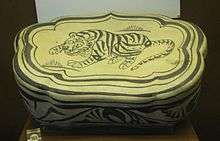
The pottery of the Song dynasty has retained emormous prestige in Chinese tradition, especially that of what later became known as the "Five Great Kilns". The artistic emphasis of Song pottery was on subtle glaze effects and graceful shapes; decoration was mostly in shallow relief. "What is clear is that in the Song Dynasty which tended to uphold the esthetics of conventional Confucianism, underglaze blue was not at all popular; Confucian esthetics emphasized simplicity, and the underglaze blue designs were judged to be too ornamental."[22]
Green ware or celadons were popular, both in China and in export markets, which became increasingly important during the period. Yue ware was succeeded by Northern Celadon and then in the south Longquan celadon. White and black wares were also important, especially in Cizhou ware, and there were polychrome types, but the finer types of ceramics, for the court and the literati, remained monochrome, relying on glaze effects and shape. A wide variety of styles evolved in various areas, and those that were successful were imitated in other areas. Important kiln sites and stoneware styles included Ru, Jun, Southern Song Guan or official ware, Jian and Jizhou. Whitish porcelain continued to be improved, and included the continuation of Ding ware and the arrival of the qingbai which would replace it.
_with_Peony%2C_Chrysanthemum%2C_and_Prunus_Sprays_LACMA_M.73.48.101.jpg)
The Liao, Xia and Jin were founded by non-literate, often nomadic people who conquered parts of China. Pottery production continued under their rule, but their own artistic traditions merged to some extent with the Chinese, producing characteristic new styles.
The pottery of all these regions was mainly high-fired, with some earthenware produced because of its lower cost and more colourful glazes. Some of the clay used was what is called kaolinite in the West. In some cases stoneware was preferred for its darker colour or better working qualities. Potteries used the local clay, and when that was dark or coarse and they wanted a fine white body, they covered the clay with white slip before applying glaze.
Yuan dynasty, 1271–1368
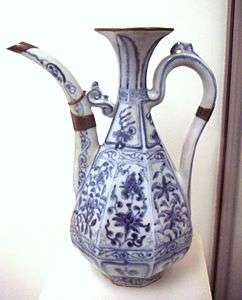
The Mongol Yuan dynasty enforced the movement of artists of all sorts around the Mongol Empire, which in ceramics brought a major stylistic and technical influence from the Islamic world in the form of blue and white porcelain, with underglaze painting in cobalt. This has been described as the "last great innovation in ceramic technology".[23] Decoration by underglaze painted patterns had long been a feature of Chinese pottery, especially in the popular Cizhou ware (mostly using black over slip), but was perhaps regarded as rather vulgar by the court and the literati class, and the finest ceramics were monochrome, using an understated aesthetic with perfect shapes and subtle glaze effects, often over shallow decoration carved or moulded into the surface.[24]
This was a great contrast to the bright colours and complicated designs developed under the Yuan, whose organization was mostly based on Islamic art, especially metalwork, although the animal and vegetable motifs remained based on Chinese tradition.[25] These were initially mainly made for export,[26] but became acceptable at court, and to buyers of fine ceramics internally. Export markets readily accepted the style, which has continued to be produced ever since, both in China and around the world.
Because of this, improvements in water transportation and the re-unification under Mongol rule, pottery production started to concentrate near deposits of kaolin, such as Jingdezhen, which gradually became the pre-eminent centre for producing porcelain in a variety of styles, a position it has held ever since. The scale of production greatly increased, and the scale and organization of the kilns became industrialized, with ownership by commercial syndicates, much division of labour, and other typical features of mass production.[27] Some other types of pottery, especially Longquan celadon and Cizhou ware, continued to flourish.
Ming dynasty, 1368–1644
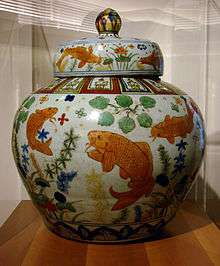
The Ming dynasty saw an extraordinary period of innovation in ceramic manufacture. Kilns investigated new techniques in design and shapes, showing a predilection for colour and painted design, and an openness to foreign forms.[28] The Yongle Emperor (1402–24) was especially curious about other countries (as evidenced by his support of the eunuch Zheng He's extended exploration of the Indian Ocean), and enjoyed unusual shapes, many inspired by Islamic metalwork.[29][30][31] During the Xuande period (1426–35), a technical refinement was introduced in the preparation of the cobalt used for underglaze blue decoration.
Prior to this the cobalt had been brilliant in colour, but with a tendency to bleed in firing; by adding manganese the colour was duller, but the line crisper. Xuande porcelain is now considered among the finest of all Ming output.[32] Enamelled decoration (such as the one at left) was perfected under the Chenghua Emperor (1464–87), and greatly prized by later collectors.[33] Indeed, by the late 16th century, Chenghua and Xuande era works – especially wine cups[34] – had grown so much in popularity, that their prices nearly matched genuine antique wares of the Song dynasty or even older. This esteem for relatively recent ceramics excited much scorn on the part of literati scholars (such as Wen Zhenheng, Tu Long, and Gao Lian, who is cited below); these men fancied themselves arbiters of taste and found the painted aesthetic 'vulgar.'[35][36]
In addition to these decorative innovations, the late Ming dynasty underwent a dramatic shift towards a market economy,[37] exporting porcelain around the world on an unprecedented scale. Thus aside from supplying porcelain for domestic use, the kilns at Jingdezhen became the main production centre for large-scale porcelain exports to Europe starting with the reign of the Wanli Emperor (1572–1620). By this time, kaolin and pottery stone were mixed in about equal proportions. Kaolin produced wares of great strength when added to the paste; it also enhanced the whiteness of the body—a trait that became a much sought after property, especially when form blue-and-white wares grew in popularity. Pottery stone could be fired at a lower temperature (1,250 °C; 2,280 °F) than paste mixed with kaolin, which required 1,350 °C (2,460 °F). These sorts of variations were important to keep in mind because the large southern egg-shaped kiln varied greatly in temperature. Near the firebox it was hottest; near the chimney, at the opposite end of the kiln, it was cooler.
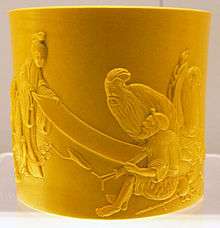
Qing dynasty, 1644–1911
Primary source material on Qing dynasty porcelain is available from both foreign residents and domestic authors. Two letters written by Père François Xavier d'Entrecolles, a Jesuit missionary and industrial spy who lived and worked in Jingdezhen in the early 18th century, described in detail manufacturing of porcelain in the city.[38] In his first letter dated 1712, d'Entrecolles described the way in which pottery stones were crushed, refined and formed into little white bricks, known in Chinese as petuntse. He then went on to describe the refining of china clay kaolin along with the developmental stages of glazing and firing. He explained his motives:
Nothing but my curiosity could ever have prompted me to such researches, but it appears to me that a minute description of all that concerns this kind of work might, be useful in Europe.
In 1743, during the reign of the Qianlong Emperor, Tang Ying, the imperial supervisor in the city produced a memoir entitled "Twenty illustrations of the manufacture of porcelain". The original illustrations have been lost, but the text of the memoir is still accessible.[39]
Types of Chinese pottery
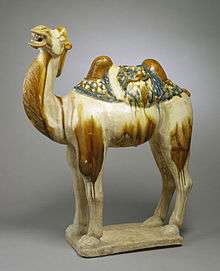
Tang burial wares
Sancai means three-colours, green, yellow and a creamy white, all in lead-based glazes. In fact some other colours could be used, including cobalt blue. In the West, Tang sancai wares were sometimes referred to as egg-and-spinach.
Sancai wares were northern wares made using white and buff-firing secondary kaolins and fire clays.[41] At kiln sites located at Tongchuan, Neiqiu County in Hebei and Gongyi in Henan,[41] the clays used for burial wares were similar to those used by Tang potters. The burial wares were fired at a lower temperature than contemporaneous whitewares. Tang dynasty tomb figures, such as the well-known representations of camels and horses, were cast in sections, in moulds with the parts luted together using clay slip. They were either painted in sancai or merely coated in white slip, often with paint added over the glaze, which has now mostly been lost. In some cases, a degree of individuality was imparted to the assembled figurines by hand-carving.
Greenwares or celadon wares
The major group of celadon wares is named for its glaze, which uses iron oxide to give a broad spectrum of colours centred on a jade or olive green, but covering browns, cream and light blues. This is a similar range to that of jade, always the most prestigious material in Chinese art, and the broad resemblance accounts for much of the attractiveness of celadon to the Chinese. Celadons are plain or decorated in relief, which may be carved, inscribed or moulded. Sometimes taken by the imperial court, celadons had a more regular market with the scholarly and middle classes, and were also exported in enormous quantities. Important types are: Yue ware, Yaozhou ware and the wider Northern Celadons, Ru ware, Guan ware, and finally Longquan celadon.
Jian ware
Jian Zhan blackwares, mainly comprising tea wares, were made at kilns located in Jianyang, Fujian province. They reached the peak of their popularity during the Song dynasty. The wares were made using locally won, iron-rich clays and fired in an oxidising atmosphere at temperatures in the region of 1,300 °C (2,370 °F). The glaze was made using clay similar to that used for forming the body, except fluxed with wood-ash. At high temperatures the molten glaze separate to produce a pattern called "hare's fur". When Jian wares were set tilted for firing, drips run down the side, creating evidence of liquid glaze pooling.
Jian tea wares of the Song dynasty were also greatly appreciated and copied in Japan, where they were known as tenmoku wares.
Renewed interest in the history and cultural heritage in China has revived starting in the 1990s. The Ji Yu Fang Lao Long kiln outside of Wuyishan, Fujian in the village of Shui Ji under Master Xiong has been able to restart production of Jian Zhan using original clay.[42] Kilns in Dehua County are also attempting in recreating it.[43]
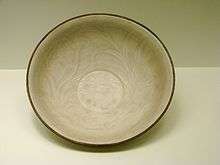
Jizhou ware
Around the same time Jizhou ware developed with it "tortoiseshell" glaze effect.
Ding ware
Ding (Wade–Giles: Ting) ware was produced in Ding County, Hebei Province. Already in production when the Song emperors came to power in 940, Ding ware was the finest porcelain produced in northern China at the time, and was the first to enter the palace for official imperial use. Its paste is white, generally covered with an almost transparent glaze that dripped and collected in "tears", (though some Ding ware was glazed a monochrome black or brown, white was the much more common type). Overall, the Ding aesthetic relied more on its elegant shape than ostentatious decoration; designs were understated, either incised or stamped into the clay prior to glazing. Due to the way the dishes were stacked in the kiln, the edged remained unglazed, and had to be rimmed in metal such as gold or silver when used as tableware. Some hundred years later, a Southern Song dynasty writer commented that it was this defect that led to its demise as favoured imperial ware.[44] Since the Song government lost access to these northern kilns when they fled south, it has been argued that Qingbai ware (see below) was viewed as a replacement for Ding.[45]
Although not as highly ranked as Ru ware, the late Ming dynasty connoisseur Gao Lian awards Ding ware a brief mention in his volume Eight Discourses on the Art of Living. Classified under his sixth discourse, the section on "pure enjoyment of cultured idleness", Master Gao says:
| “ | "The best sort has marks on it like tear-stains… Great skill and ingenuity is displayed in selecting the forms of the vessels..."[46] | ” |
Ru ware
Like Ding ware, Ru ware (Wade–Giles : ju) was produced in North China for imperial use. The Ru kilns were near the Northern Song capital at Kaifeng. In similar fashion to Longquan celadons, Ru pieces have small amounts of iron oxide in their glaze that oxidize and turn greenish when fired in a reducing atmosphere. Ru wares range in colour—from nearly white to a deep robin's egg—and often are covered with reddish-brown crackles. The crackles, or "crazing", are caused when the glaze cools and contracts faster than the body, thus having to stretch and ultimately to split, (as seen in the detail at right; see also ). The art historian James Watt comments that the Song dynasty was the first period that viewed crazing as a merit rather than a defect. Moreover, as time went on, the bodies got thinner and thinner, while glazes got thicker, until by the end of the Southern Song the 'green-glaze' was thicker than the body, making it extremely 'fleshy' rather than 'bony,' to use the traditional analogy (see section on Guan ware, below). Too, the glaze tends to drip and pool slightly, leaving it thinner at the top, where the clay peeps through.
As with Ding ware, the Song imperial court lost access to the Ru kilns after it fled Kaifeng when the Jurchen-led Jin dynasty conquered northern China, and settled at Lin'an (present-day Hangzhou) in the south. There, the Emperor Gaozong founded the Guan yao ('official kilns') right outside the new capital in order to produce imitations of Ru ware.[48] However, posterity has remembered Ru ware as something unmatched by later attempts; Master Gao says, "Compared with Guan yao, the above were of finer substance and more brilliant luster."[49]
Jun ware
Jun (Wade–Giles : chün) ware was a third style of porcelain used at the Northern Song court. Characterized by a thicker body than Ding or Ru ware, Jun is covered with a turquoise and purple glaze, so thick and viscous looking that it almost seems to be melting off its substantial golden-brown body. Not only are Jun vessels more thickly potted, their shape is much more robust than the fine Jun pieces, yet both types were appreciated at the court of Emperor Huizong. Jun production was centered at Jun-tai in Yuzhou, Henan Province.[44]
Guan ware
Guan (Wade–Giles : kuan) ware, literally means "official" ware; so certain Ru, Jun, and even Ding are Guan in the broad sense of being produced for the court. Usually the term in English only applies to that produced by an official, imperially run kiln, which did not start until the Southern Song dynasty fled from the advancing Jin dynasty and settled at Lin'an. It was during this period that walls become so thin and glaze so thick that the latter superseded the former in breadth. As the clay in the foothills around Lin'an, was a brownish colour, and the glaze so viscous.[51]
Ge ware
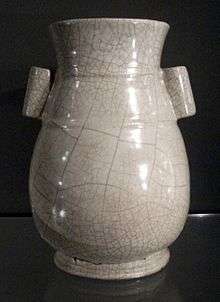
Ge (Wade–Giles : ko), literally means 'big-brother' ware, because legend has it that of two brothers working in Longquan, one made the typical celadon style ceramics, but the elder made ge ware, produced in his private kiln. Ming dynasty commentator Gao Lian claims that the ge kiln took its clay from the same site as Guan ware, which is what accounts for the difficulty in distinguishing one from the other (though Gao thinks "Ge is distinctly inferior" to Guan).[52] Overall, Ge remains somewhat elusive, but basically comprises two types—one with a 'warm rice-yellow glaze and two sets of crackles, a more prominent set of darker colour interspersed with a finer set of reddish lines' (called chin-ssu t'ieh-hsien or 'golden floss and iron threads', which can just faintly be detected on this bowl).[53] The other Ge ware is much like Guan ware, with grayish glaze and one set of crackles. Once thought to have only been manufactured alongside Longquan celadon, per its legendary founding, Ge is now believed to have also been produced at Jingdezhen.[54]
While similar to Guan ware, Ge typically has a grayish-blue glaze that is fully opaque with an almost matte finish. Its crackle pattern is exaggerated, often standing out in bold black. Though still shrouded in mystery, many specialists believe that Ge ware did not develop until the very late Southern Song dynasty or even the Yuan dynasty. In any case, enthusiasm for it persisted throughout the Ming dynasty; Wen Zhenheng preferred it to all other types of porcelain, in particular for brush washers and water droppers (although he preferred jade brush washers to porcelain, Guan and Ge were the best ceramic ones, especially if they have scalloped rims). Differences between later Ming imitations of Song/Yuan Ge include: Ming versions substitute a white porcelain body; they tend to be produced in a range of new shapes, for example those for the scholar's studio; glazes tend to be thinner and more lustrous; and slip is applied to the rim and base to simulate the "brown mouth and iron foot" of Guan ware.[55]
Qingbai wares
Qingbai wares (also called 'yingqing')[56] were made at Jingdezhen and at many other southern kilns from the time of the Northern Song dynasty until they were eclipsed in the 14th century by underglaze-decorated blue and white wares. Qingbai in Chinese literally means "clear blue-white". The qingbai glaze is a porcelain glaze, so-called because it was made using pottery stone. The qingbai glaze is clear, but contains iron in small amounts. When applied over a white porcelain body the glaze produces a greenish-blue colour that gives the glaze its name. Some have incised or moulded decorations.
The Song dynasty qingbai bowl illustrated was likely made at the Jingdezhen village of Hutian, which was also the site of the imperial kilns established in 1004. The bowl has incised decoration, possibly representing clouds or the reflection of clouds in the water. The body is white, translucent and has the texture of very-fine sugar, indicating that it was made using crushed and refined pottery stone instead of pottery stone and kaolin. The glaze and the body of the bowl would have been fired together, in a saggar in a large wood-burning dragon kiln, typical of southern kilns in the period.
Though many Song and Yuan dynasty qingbai bowls were fired upside down in special segmented saggars, a technique first developed at the Ding kilns in Hebei province. The rims of such wares were left unglazed but were often bound with bands of silver, copper or lead.
One remarkable example of qingbai porcelain is the so-called Fonthill Vase, described in a guide for Fonthill Abbey published in 1823:
...an oriental china bottle, superbly mounted, said to be the earliest known specimen of porcelain introduced into Europe
The vase was made at Jingdezhen, probably around 1300 and was sent as a present to Pope Benedict XII by one of the last Yuan emperors of China, in 1338. The mounts referred to in the 1823 description were of enamelled silver-gilt and were added to the vase in Europe in 1381. An 18th-century water colour of the vase complete with its mounts exists, but the mounts themselves were removed and lost in the 19th century. The vase is now in the National Museum of Ireland. It is often held that qingbai wares were not subject to the higher standards and regulations of the other porcelain wares, since they were made for everyday use. They were mass-produced, and received little attention from scholars and antiquarians. The Fonthill Vase, given by a Chinese emperor to a pope, might appear to cast at least some doubt on this view.
Blue and white wares
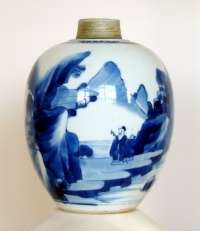
Following in the tradition of earlier qingbai porcelains, blue and white wares are glazed using a transparent porcelain glaze. The blue decoration is painted onto the body of the porcelain before glazing, using very finely ground cobalt oxide mixed with water. After the decoration has been applied the pieces are glazed and fired.
It is believed that underglaze blue and white porcelain was first made in the Tang dynasty. Only three complete pieces of Tang blue and white porcelain are known to exist (in Singapore from the Indonesian Belitung shipwreck), but shards dating to the 8th or 9th century have been unearthed at Yangzhou in Jiangsu Province. It has been suggested that the shards originated from a kiln in the province of Henan. In 1957, excavations at the site of a pagoda in Zhejiang province uncovered a Northern Song bowl decorated with underglaze blue and further fragments have since been discovered at the same site. In 1970 a small fragment of a blue and white bowl, again dated to the 11th century, was also excavated in the province of Zhejiang.
In 1975, shards decorated with underglaze blue were excavated at a kiln site in Jiangxi and, in the same year, an underglaze blue and white urn was excavated from a tomb dated to 1319, in the province of Jiangsu. It is of interest to note that a Yuan funerary urn decorated with underglaze blue and underglaze red and dated 1338 is still in the Chinese taste, even though by this time the large-scale production of blue and white porcelain in the Yuan dynasty, Mongol taste had started its influence at Jingdezhen.
Starting early in the 14th century, blue and white porcelain rapidly became the main product of Jingdezhen, reaching the height of its technical excellence during the later years of the reign of the Kangxi Emperor[57] and continuing in present times to be an important product of the city.
The tea caddy illustrated shows many of the characteristics of blue and white porcelain produced during the Kangxi period. The translucent body showing through the clear glaze is of great whiteness and the cobalt decoration, applied in many layers, has a fine blue hue. The decoration, a sage in a landscape of lakes and mountains with blazed rocks is typical of the period. The piece would have been fired in a saggar (a lidded ceramic box intended to protect the piece from kiln debris, smoke and cinders during firing) in a reducing atmosphere in a wood-burning egg-shaped kiln, at a temperature approaching 1,350 °C (2,460 °F).
Distinctive blue-and-white porcelain was exported to Japan where it is known as Tenkei blue-and-white ware or ko sometsukei. This ware is thought to have been especially ordered by tea masters for Japanese ceremony.

Blanc de Chine
Blanc de Chine is a type of white porcelain made at Dehua in Fujian province. It has been produced from the Ming dynasty (1368–1644) to the present day. Large quantities arrived in Europe as Chinese Export Porcelain in the early 18th century and it was copied at Meissen and elsewhere.
The area along the Fujian coast was traditionally one of the main ceramic exporting centers. Over 180 kiln sites have been identified extending in historical range from the Song dynasty to the present.
From the Ming dynasty, porcelain objects were manufactured that achieved a fusion of glaze and body traditionally referred to as "ivory white" and "milk white". The special characteristic of Dehua porcelain is the very small amount of iron oxide in it, allowing it to be fired in an oxidising atmosphere to a warm white or pale ivory colour. (Wood, 2007)
The porcelain body is not very plastic but vessel forms have been made from it. Donnelly, (1969, pp.xi-xii) lists the following types of product: figures, boxes, vases and jars, cups and bowls, fishes, lamps, cup-stands, censers and flowerpots, animals, brush holders, wine and teapots, Buddhist and Taoist figures, secular figures and puppets. There was a large output of figures, especially religious figures, e.g. Guanyin, Maitreya, Lohan and Ta-mo figures.
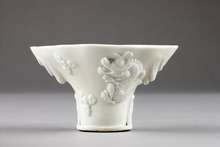
The numerous Dehua porcelain factories today make figures and tableware in modern styles. During the Cultural Revolution "Dehua artisans applied their very best skills to produce immaculate statuettes of Mao Zedong and the Communist leaders. Portraits of the stars of the new proletarian opera in their most famous roles were produced on a truly massive scale."[58] Mao Zedong figures later fell out of favour but have been revived for foreign collectors.
Notable artists in blanc de Chine, such as the late Ming period He Chaozong, signed their creations with their seals. Wares include crisply modeled figures, cups, bowls and joss stick-holders.
Many of the best examples of blanc de Chine are found in Japan where the white variety was termed hakugorai or "Korean white", a term often found in tea ceremony circles. The British Museum in London has a large number of blanc de Chine pieces, having received as a gift in 1980 the entire collection of P.J.Donnelly.[59]
Classification by colour, the "Famille" groups
Commonly used French terms for 'families', or palettes of enamel colours used on Chinese porcelain. Famille jaune, noire, rose, verte are terms used to classify Chinese porcelain by the dominant element in its colour palette.
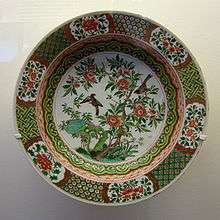
Famille verte (康熙五彩, Kangxi wucai, also 素三彩, Susancai), adopted in the Kangxi period (1662–1722), uses green and iron red with other overglaze colours. It developed from the Wucai (五彩, "Five colours") style.
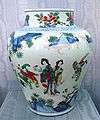 Wucai vase, Shunzhi period, circa 1650–1660
Wucai vase, Shunzhi period, circa 1650–1660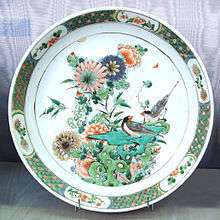 Wucai plate for exportation, Kangxi period, circa 1680
Wucai plate for exportation, Kangxi period, circa 1680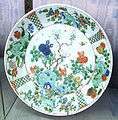 Wucai plate for exportation, Kangxi period, circa 1680
Wucai plate for exportation, Kangxi period, circa 1680
Famille jaune is a variation using famille verte enamels on a yellow ground. Famille noire (Chinese: 黑地素三彩, Modi susancai) uses a black ground (although some clobbered wares had the black added in the 19th century).
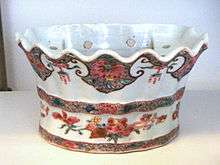
Famille rose (known in Chinese as Fencai (粉彩) or Ruancai (軟彩, simplified 软彩), meaning 'soft colours', and later as Yangcai (洋彩), meaning 'foreign colours') was introduced during the reign of the Kangxi Emperor (1654–1722), possibly around 1720. It used mainly pink or purple and remained popular throughout the 18th and the 19th centuries, also being widely adopted by European factories.
Famille rose enamel ware allows a greater range of colour and tone than was previously possible, enabling the depiction of more complex images, including flowers, figures and insects.
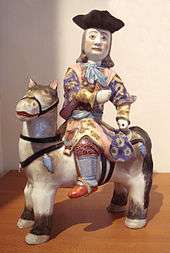 Qing dynasty Chinese export porcelain with European figure, Famille rose, first half of 18th century
Qing dynasty Chinese export porcelain with European figure, Famille rose, first half of 18th century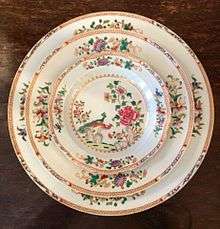 Double Peacock Dinner Service, late 18th century Chinese export porcelain. Famille rose service with two peacocks over a rock
Double Peacock Dinner Service, late 18th century Chinese export porcelain. Famille rose service with two peacocks over a rock
Stoneware
Pottery classified as stoneware in the West is usually regarded as porcelain in Chinese terms, where a stoneware group is not recognised, and so the definition of porcelain is rather different, covering all vitrified high-fired wares. Terms such as "porcellaneous" and "near-porcelain" are often used to reflect this, and cover wares that in Western terms lie on the border of stoneware and porcelain. High-fired stonewares were numerous from very early on, and included many high-prestige wares, including those for imperial use, as well as great quantities of everyday utilitarian pots. Usually they achieved their reputation by their glazes. Most of the celadon group, including Longquan celadons, especially earlier ones, can be classified as stoneware, and all classic Jian wares and Jizhou wares.
By contrast, the Yixing clay teapots and cups made from Yixing clay from Jiangsu province are usually left unglazed, and not washed after use, as the clay is believed to improve the taste of the tea, especially after it acquires a patina from long use. There are in fact a number of different clays, giving a range of colours. The pots are unusual in that they are often signed by their potters, which is very rare in China, perhaps because they were associated with the literati culture, of which Jiangsu was a stronghold. The earliest datable example is from a burial of 1533 in Nanjing. Elaborately decorated examples, often with a rectangular body, were exported to Europe from the 18th century, and these and pots for local use often had poems inscribed on them. As well as teaware and desk objects such as brush-rests, fruit and other natural shapes were modelled as ornaments. Production continues today, generally using simpler shapes.[60]
Fakes and reproductions

Chinese potters have a long tradition of borrowing design and decorative features from earlier wares. Whilst ceramics with features thus borrowed might sometimes pose problems of provenance, they would not generally be regarded as either reproductions or fakes. However, fakes and reproductions have also been made at many times during the long history of Chinese ceramics and continue to be made today in ever-increasing numbers.
- Reproductions of Song dynasty Longquan celadon wares were made at Jingdezhen in the early 18th century, but outright fakes were also made using special clay that were artificially aged by boiling in meat broth, refiring and storage in sewers. Père d'Entrecolles records that by this means the wares could be passed off as being hundreds of years old.[38]
- In the late 19th century, fakes of Kangxi period famille noire wares were made that were convincing enough to deceive the experts of the day. Many such pieces may still be seen in museums today, as may pieces of genuine Kangxi porcelain were decorated in the late nineteenth century with famille noire enamels. A body of modern expert opinion holds that porcelain decorated with famille noire enamels was not made at all during the Kangxi period, though this view is disputed.[57]
- A fashion for Kangxi period (1662 to 1722) blue and white wares grew to large proportions in Europe during the later years of the 19th century and triggered the production at Jingdezhen of large quantities of porcelain wares that strike a resemblance to ceramics of earlier periods. Such blue and white wares were not fakes or even convincing reproductions, even though some pieces carried four-character Kangxi reign-marks that continue to cause confusion to this day. Kangxi reign-marks in the form shown in the illustration occur only on wares made towards the end of the 19th century or later, without exception.
Authentication
The most widely known test is the thermoluminescence test, or TL test, which is used on some types of ceramic to estimate, roughly, the date of last firing. Thermoluminescence dating is carried out on small samples of pottery drilled or cut from the body of a piece, which can be risky and disfiguring. For this reason, the test is rarely used for dating finely potted, high-fired ceramics. TL testing cannot be used at all on some types of ceramics, particularly high-fired porcelain.
Gallery
Early wares
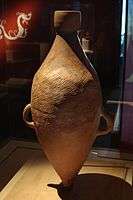 Water jar from the Neolithic period, Yangshao culture (ca. 5000-3000 BC)
Water jar from the Neolithic period, Yangshao culture (ca. 5000-3000 BC)- Painted pot with frog motifs, Majiayao culture (2200–2000 BC)
- Painted pot of Majiayao culture (2200–2000 BC)
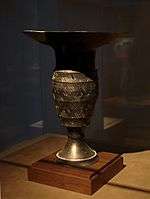 Black pottery goblet of the Late Neolithic period from the Longshan culture, dated (ca. 2500–2000 BC)
Black pottery goblet of the Late Neolithic period from the Longshan culture, dated (ca. 2500–2000 BC)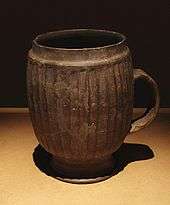 Large grey mug, Henan Longshan culture, Late Neolithic period (ca. 2500–2000 BC)
Large grey mug, Henan Longshan culture, Late Neolithic period (ca. 2500–2000 BC).jpg) White pottery pitcher from the Shandong Longshan culture, 2500–2000 BC
White pottery pitcher from the Shandong Longshan culture, 2500–2000 BC- White pottery pot with geometric design, Shang dynasty (1600–1100 BC)
- Earthenware vase, Eastern Zhou, 4th-3rd century BC, British Museum
-ShanghaiMuseum-May27-08.jpg) A pottery bell from the Warring States period (403–221 BC)
A pottery bell from the Warring States period (403–221 BC)- A painted pottery dou vessel with a dragon design from the Warring States period (403-221 BC)
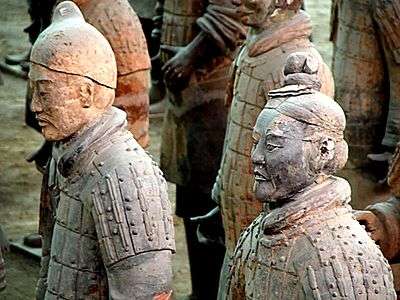 Soldiers from the Terracotta Army, interred by 210 BC, Qin dynasty (221–206 BC)
Soldiers from the Terracotta Army, interred by 210 BC, Qin dynasty (221–206 BC)
Han (202 BC to 220 AD)
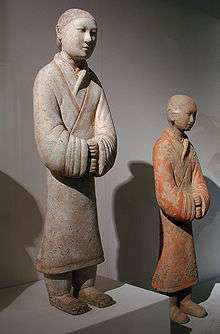 Ceramic sculptures with polychrome, from the 2nd century BC, Han dynasty.
Ceramic sculptures with polychrome, from the 2nd century BC, Han dynasty.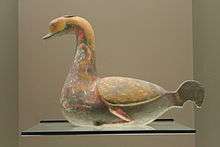 An earthenware goose pourer with lacquerware paint designs, Western Han dynasty, late 3rd century BC to early 1st century AD
An earthenware goose pourer with lacquerware paint designs, Western Han dynasty, late 3rd century BC to early 1st century AD- A painted earthenware tripod, Western Han dynasty, late 3rd century BC to early 1st century AD
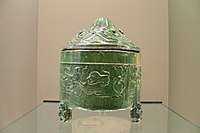 A Han celadon pot with mountain-shaped lid and animal designs
A Han celadon pot with mountain-shaped lid and animal designs Two Western Han dynasty terracotta vases with acrobats
Two Western Han dynasty terracotta vases with acrobats Ceramic tomb statuette of a cavalryman and horse, Western Han dynasty
Ceramic tomb statuette of a cavalryman and horse, Western Han dynasty- An Eastern Han pottery tomb model of residential towers joined by a bridge
- A Han pottery face of a laughing woman
- A footed Western Han white ceramic wine warmer with animal-head figurines decorating its lid
- An Eastern Han ceramic candle-holder with animal figurines
Three Kingdoms, Jin, Southern and Northern Dynasties, Sui (220 to 618)
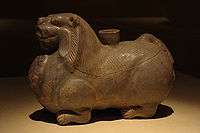 A celadon ceramic candle holder in the shape of a crouched lion, Three Kingdoms period (220–265), made in Eastern Wu
A celadon ceramic candle holder in the shape of a crouched lion, Three Kingdoms period (220–265), made in Eastern Wu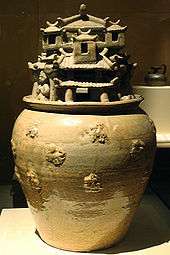
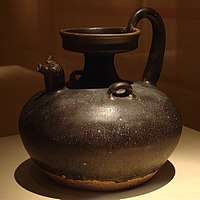 A black-glazed wine or water jug with a rooster-headed spout, Jin dynasty (265-420)
A black-glazed wine or water jug with a rooster-headed spout, Jin dynasty (265-420)- A footed earthenware lamp with lions, from either the Northern Dynasties period or Sui dynasty, 6th century
- Covered footed earthenware vessel from the Northern Qi (550–577)
- Northern Dynasties lotus vessel
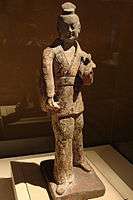 A Western Wei (536–556) ceramic figurine of a military officer
A Western Wei (536–556) ceramic figurine of a military officer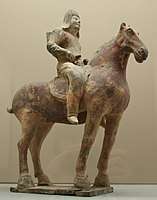 A ceramic cavalryman with a horn, Northern Wei (386–534)
A ceramic cavalryman with a horn, Northern Wei (386–534)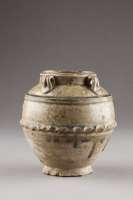 Grey stoneware jar with high-fired glaze. Sui dynasty (581-618).The jar is a utilitarian object with lugs on its shoulder to secure a cloth or rattan lid.
Grey stoneware jar with high-fired glaze. Sui dynasty (581-618).The jar is a utilitarian object with lugs on its shoulder to secure a cloth or rattan lid.
Tang (618 to 906 AD)
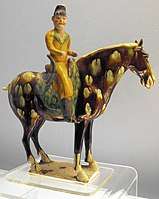 Sancai-horse and figurine, Tang dynasty
Sancai-horse and figurine, Tang dynasty- A sancai glazed pottery horse from the 7th-8th century
- An earthenware jar with green and yellow glaze, first half of 8th century
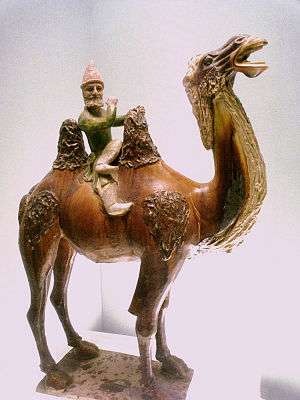 A Sogdian man of the Western Regions riding a Bactrian Camel, a sancai glazed figurine from the Tang dynasty
A Sogdian man of the Western Regions riding a Bactrian Camel, a sancai glazed figurine from the Tang dynasty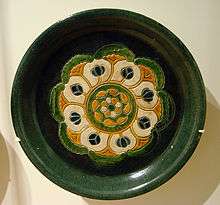 A rounded ceramic plate with sancai "three colours" glaze, 8th century
A rounded ceramic plate with sancai "three colours" glaze, 8th century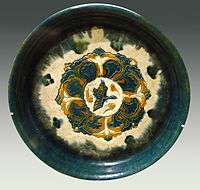 A ceramic offering plate with "three colours" glaze, decorated with a bird and trees, 8th century
A ceramic offering plate with "three colours" glaze, decorated with a bird and trees, 8th century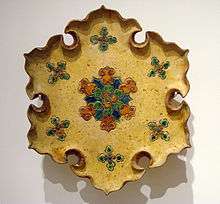 A ceramic offering plate with six eaves and "three colours" glaze, 8th century
A ceramic offering plate with six eaves and "three colours" glaze, 8th century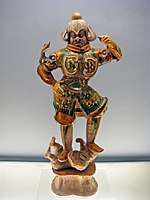 The Statue of Heavenly Guardian, Polychrome glazed pottery, Tang dynasty.
The Statue of Heavenly Guardian, Polychrome glazed pottery, Tang dynasty.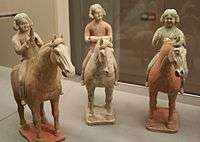 Tang female musicians on horseback
Tang female musicians on horseback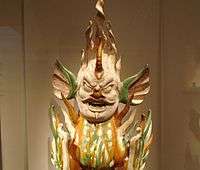 A Tang sancai-glazed tomb guardian, 8th century
A Tang sancai-glazed tomb guardian, 8th century Earthenware figures of female attendants, with coloured lead glazes, Tang dynasty, early 8th century.
Earthenware figures of female attendants, with coloured lead glazes, Tang dynasty, early 8th century.
Song (960 to 1279 AD)
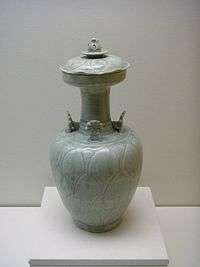 Funerary vase and cover, green-glazed Longquan celadon, Northern Song (960–1127)
Funerary vase and cover, green-glazed Longquan celadon, Northern Song (960–1127)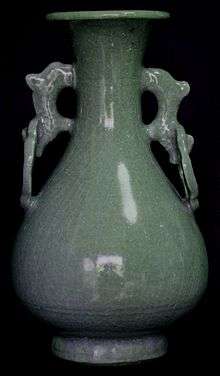 A Longquan celadon vase from the Song dynasty
A Longquan celadon vase from the Song dynasty- Southern Song dynasty celadon vase with dish shaped mouth, Longquan celadon
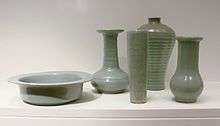 Longquan celadon wares, 13th century
Longquan celadon wares, 13th century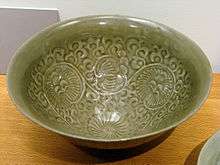 Yaozhou ware celadon bowl, 10th-11th century
Yaozhou ware celadon bowl, 10th-11th century- Celadon amphora with dragon handles
- Celadon vase from the Khitan-led Liao Dynasty (907-1125 AD)
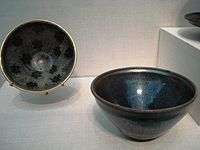
- Qingbai teapot, from Jingdezhen
 Ding ware porcelain dish with transparent glaze and carved decoration, 11th-early 12th century.
Ding ware porcelain dish with transparent glaze and carved decoration, 11th-early 12th century.- Qingbai box with flower medallions
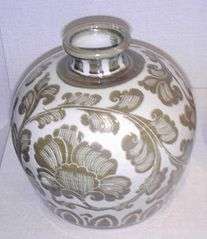 Ding ware bottle with iron pigment over transparent colourless glaze, 11th century; Freer Gallery, F1959.6.
Ding ware bottle with iron pigment over transparent colourless glaze, 11th century; Freer Gallery, F1959.6.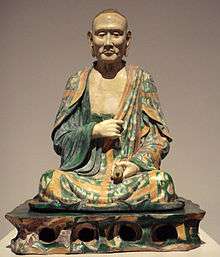 One of the famous set of lifesize Yixian glazed pottery luohans, sancai, early 12th century
One of the famous set of lifesize Yixian glazed pottery luohans, sancai, early 12th century- Northern Song dynasty white-glazed baby boy pillow
- A glazed stoneware pillow from the Song dynasty, Cizhou ware
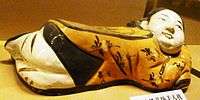 Porcelain pillow Jin dynasty (1115–1234), Cizhou ware
Porcelain pillow Jin dynasty (1115–1234), Cizhou ware
Yuan (1279 to 1368 AD)
- A celadon shoulder pot from the late Yuan dynasty, displaying artwork of peaches, lotuses, peonies, willows, and palms
 Qingbai porcelain vase, 14th century
Qingbai porcelain vase, 14th century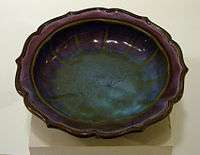
- Longquan celadon, 13th-14th century
- Longquan celadon bowl with a dragon
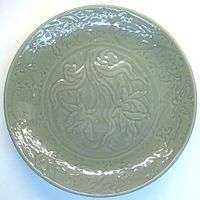 Celadon dish with a flower design
Celadon dish with a flower design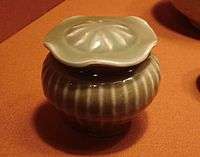 A covered jar made of Longquan celadon, 14th century
A covered jar made of Longquan celadon, 14th century- A Jun ware bowl
- A white porcelain statue depicting Guanyin, Yuan dynasty
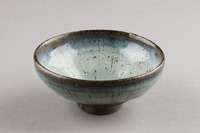 Jun ware bowl. Liquid-liquid phase separation.
Jun ware bowl. Liquid-liquid phase separation.
Ming (1368 to 1644 AD)
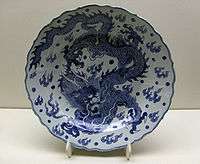 A Ming Dynasty blue-and-white porcelain dish with depiction of a dragon
A Ming Dynasty blue-and-white porcelain dish with depiction of a dragon- Guanyin (Goddess of Mercy) with children, statuette made of Dehua porcelain ware
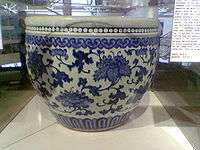 A Ming dynasty porcelain bowl with flower designs
A Ming dynasty porcelain bowl with flower designs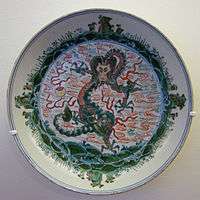 Porcelain plate from 1634, during the Chongzhen period (1627–1644)
Porcelain plate from 1634, during the Chongzhen period (1627–1644)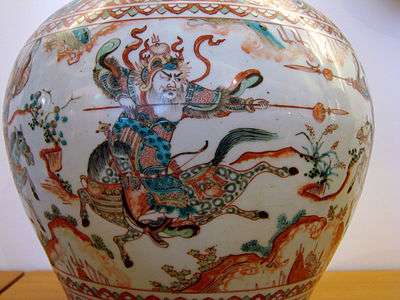 Porcelain vase from the reign of the Jiajing Emperor (1521–1567)
Porcelain vase from the reign of the Jiajing Emperor (1521–1567)- A Ming glazed earthenware statue of a seated Buddha
- Yongle period red plate
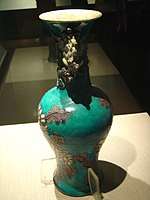 Chrysanthemum styled porcelain vase with three colours
Chrysanthemum styled porcelain vase with three colours- Jiajing period covered jar with green dragon and cloud design
- Wanli period covered jar in green
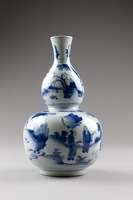 Bottle, late Ming dynasty Chongzhen 1628-44.
Bottle, late Ming dynasty Chongzhen 1628-44.
Qing (1644 to 1912 AD)
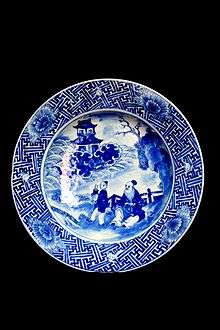 Kangxi transitional porcelain, 1644-1680
Kangxi transitional porcelain, 1644-1680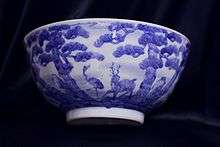 Kangxi transitional porcelain, 1644-1680
Kangxi transitional porcelain, 1644-1680 Porcelain plate from the reign of the Kangxi Emperor (1661–1722)
Porcelain plate from the reign of the Kangxi Emperor (1661–1722)- A porcelain bowl with a scene of two boys playing in a courtyard, from the reign of the Yongzheng Emperor (1722–1735)
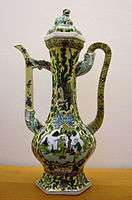 Porcelain vase from the reign of the Kangxi Emperor (1661–1722)
Porcelain vase from the reign of the Kangxi Emperor (1661–1722)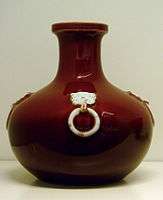 Copper-red porcelain from the reign of the Yongzheng Emperor (1722–1735)
Copper-red porcelain from the reign of the Yongzheng Emperor (1722–1735)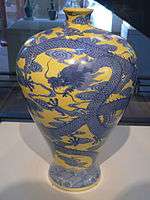 Porcelain from the reign of the Qianlong Emperor (1735–1796)
Porcelain from the reign of the Qianlong Emperor (1735–1796)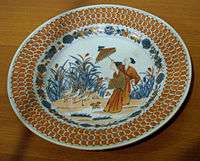 Porcelain plate from the reign of the Qianlong Emperor (1735–1796)
Porcelain plate from the reign of the Qianlong Emperor (1735–1796)- Four ritual porcelain water vessels with elephant-trunk spouts, from the reign of the Qianlong Emperor (1735–1796)
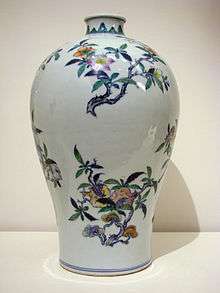 An 18th-century Qing porcelain meiping (梅瓶; plum vase)
An 18th-century Qing porcelain meiping (梅瓶; plum vase)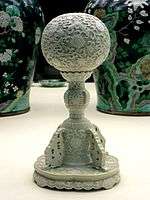 White porcelain from the reign of the Qianlong Emperor (1735–1796)
White porcelain from the reign of the Qianlong Emperor (1735–1796)_(10876361736).jpg) Porcelain vase decorated with flowers and birds made at Jingdezhen, Jiangxi,
Porcelain vase decorated with flowers and birds made at Jingdezhen, Jiangxi,- 19th century porcelain vase with cover painted with overglaze enamels from Guangdong province. This type of ware, known for its colourful decoration that covers most of the surface of the piece, was popular as an export ware
_(6175354053).jpg) A collection of various forms of porcelain from the Qing dynasty
A collection of various forms of porcelain from the Qing dynasty.jpg) Vases from the collection of prince-cardinal Louis René de Rohan
Vases from the collection of prince-cardinal Louis René de Rohan
Republic and People's Republic (1912 to date)
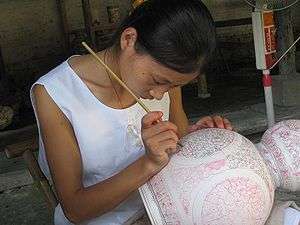 Decorating porcelain in modern-day Jingdezhen
Decorating porcelain in modern-day Jingdezhen
See also
| Wikimedia Commons has media related to Porcelain of China. |

- Arts of China
- Canton porcelain (Jingdezhen porcelain decorated at Canton for export to the West)
- China painting
- Chinese art
- Chinese export porcelain (Chinese porcelain made for export to the West).
- Dehua porcelain factories (the factories at Dehua)
- Kraak porcelain (blue and white export wares in the Dutch taste)
- Shiwan Ware
- Swatow ware (wares exported through the port of Swatow)
- Sydney punchbowls
- Dangyangyu Kiln
- Tiger Cave Kiln (site of much of Southern Song official celadon ware)
- Vietnamese ceramics
- Martaban (Chinese stoneware highly valued in the precolonial maritime trade of island Southeast Asia)
References
- ↑ An Introduction To The Technology Of Pottery. 2nd edition. Paul Rado. Pergamon Press, Institute of Ceramics. 1988.
- ↑ Pierson, Stacey, (1996). Earth, Fire and Water: Chinese Ceramic Technology. Percival David Foundation of Chinese Art, University of London. ISBN 0-7286-0265-2.
- ↑ Valenstein, S. (1998). A handbook of Chinese ceramics, pp. 22, 59–60, 72, Metropolitan Museum of Art, New York. ISBN 9780870995149
- ↑ Bushell, S. W. (1977) Chinese Pottery and Porcelain. Oxford University Press, Kuala Lumpur. ISBN 0-19-580372-8.
- ↑ Korean art from the Gompertz and other collections in the Fitzwilliam Museum, ed. Yong-i Yun, Regina Krahl (chapter by Nigel Wood), p. 13
- ↑ Kerr, Rose and Wood, Nigel (2004). Science and Civilisation in China, Volume 5, Part XII: Ceramic Technology. Cambridge University Press. ISBN 0-521-83833-9.
- ↑ Rawson, 364, 369–370; Vainker, 222–223
- ↑ "Harvard, BU researchers find evidence of 20,000-year-old pottery" Archived 2013-01-02 at Archive.is. Boston.com, reporting Science paper.
- ↑ "Remnants of an Ancient Kitchen Are Found in China". The New York Times.
- ↑ "Chinese pottery may be earliest discovered." Associated Press. 2009-06-01, reporting on paper in the Proceedings of the National Academy of Sciences.
- ↑ Hung, Ling-yu (2011), Pottery Production, Mortuary Practice, and Social Complexity in the Majiayao Culture, NW China (ca. 5300-4000 BP) (PhD) (589), Washington University in St. Louis: All Theses and Dissertations (ETDs)
- ↑ Vainker, 15–20
- ↑ Vainker, 12
- ↑ Vainker, 19
- ↑ Vainker, 20–21
- ↑ He Li, (1996). Chinese Ceramics. The New Standard Guide. The Han Dynasty made the first ceramics to survive appreciable quantities. Thames and Hudson, London. ISBN 0-500-23727-1.
- 1 2 Temple, Robert K.G. (2007). The Genius of China: 3,000 Years of Science, Discovery, and Invention (3rd edition). London: André Deutsch, pp. 103–6. ISBN 978-0-233-00202-6
- ↑ Dien, Albert E. (2007), Six dynasties civilization, Early Chinese civilization series, Yale University Press, pp. 214–215, ISBN 0-300-07404-2
- ↑ Vainker, 82–84
- ↑ Vainker, 64–72
- ↑ Bushell, S. W. (1906). Chinese Art. Victoria and Albert Museum Art Handbook, His Majesty's Stationery Office, London.
- ↑ Zhiyan, Li, et al. (2010) Chinese Ceramics, From the paleolithic period through the Qing dynasty. Yale University Press, New Haven & London; Foreign Language Press, Beijing. ISBN 978-0-300-11278-8. p. 313.
- ↑ Medley, 169
- ↑ Vainker, 115–117, 180
- ↑ Medley, 180–182
- ↑ Vainker, 139–140, 180
- ↑ Medley, 171
- ↑ Lion-Goldschmidt, Ming Porcelain, pp. 20, 47.
- ↑ "Buddhist Ablution Basin". Asian Art Museum. Archived from the original on 2008-12-09.
- ↑ Handled Ewer, Asian Art Museum, archived from the original on 2008-12-09
- ↑ Li He and Michael Knight, Power and Glory: Court Art of China's Ming Dynasty (San Francisco: Asian Art Museum, 2008), p. 130.
- ↑ Watt, Possessing the Past, pp. 439–41.
- ↑ James C.Y. Watt, "Official Art and Commercial Art," in Possessing the Past, p. 441.
- ↑ Wine cup, Met
- ↑ James C.Y. Watt, "The Literati Environment," in The Chinese Scholar's Studio, pp. 1–13.
- ↑ Craig Clunas, Superfluous Things: Material Culture and Social Status in Early Modern China. Urbana: University of Illinois Press, 1991 and Honolulu: University of Hawai'i Press, 2004.
- ↑ On the development of a market system and its impact on material culture more generally, see Timothy Brook, The Confusions of Pleasure: Commerce and Culture in Ming China (Berkeley and Los Angeles: University of California Press, 1998).
- 1 2 see: Two letters written by Père Francois Xavier d'Entrecolles at Ceramics Today.com
- ↑ "Tang Ying's "Twenty illustrations of the manufacture of porcelain."". Seattle Art Museum. Archived from the original on 2008-12-09. Retrieved 29 March 2018.
- ↑ "Camel". The Walters Art Museum.
- 1 2 Wood, Nigel (1999). Chinese Glazes. A.C. Black, London. ISBN 0-7136-3837-0
- ↑ "Reviving the Song Dynasty Jian Zhan Tradition". verdanttea.com. Retrieved 29 March 2018.
- ↑ "Jian Zhan - Verdant Tea". verdanttea.com. Retrieved 29 March 2018.
- 1 2 James C.Y. Watt, "Antiquarianism and Naturalism," in Possessing the Past, pp. 236–38.
- ↑ "Qingbai wine ewer and basin". The British Museum.
- ↑ Gao Lian, "The Tsun Sheng Pa Chien, AD 1591, by Kao Lien," tr. Arthur Waley, Yearbook of Oriental Art and Culture, 1, (1924–25), p. 86. See also Clunas, Superfluous Things, pp. 13–20.
- 1 2 "Bowl stand | V&A Search the Collections". Collections.vam.ac.uk. 2012-12-04. Archived from the original on 2008-12-09. Retrieved 2012-12-21.
- ↑ James C.Y. Watt, "Antiquarianism and Naturalism," in Possessing the Past, pp. 238–42.
- ↑ Gao Lian, "The Tsun Sheng Pa Chien, AD 1591, by Kao Lien," p. 82.
- ↑ "Archived copy". Archived from the original on 2008-12-09. Retrieved 2008-10-13.
- ↑ ‘Sheng Pa Chien, AD 1591, by Kao Lien," pp. 82–4.
- ↑ Gao Lian, "The Tsun Sheng Pa Chien, AD 1591, by Kao Lien," p. 84–5.
- ↑ "Song Ge Ware Footed Bowl, Chinese". Seco.glendale.edu. Archived from the original on 2012-12-14. Retrieved 2012-12-21.
- ↑ James C.Y. Watt, "Antiquarianism and Naturalism," in Possessing the Past, pp. 245–38.
- ↑ Robert Mowry The Chinese scholar's studio, p. 164
- ↑ Wood, Nigel, Chinese Glazes
- 1 2 de Boulay, Anthony (1973). Chinese Porcelain. Octopus Books, London. ISBN 0-7064-0045-3
- ↑ (Ayers and Bingling, 2002)
- ↑ (Harrison-Hall, 2001)
- ↑ Vainker, 173–175
Bibliography
- Ayers, J. and Bingling, Y., (2002) Blanc de Chine: Divine Images in Porcelain, China Institute, New York
- Ayers, J and Kerr, R., (2000), Blanc de Chine Porcelain from Dehua, Art Media Resources Ltd.
- Brook, Timothy. The Confusions of Pleasure: Commerce and Culture in Ming China. Berkeley and Los Angeles: University of California Press, 1998. ISBN 0-520-22154-0.
- Clunas, Craig. Superfluous Things: Material Culture and Social Status in Early Modern China. Urbana: University of Illinois Press, 1991 and Honolulu: University of Hawai'i Press, 2004.
- Donnelly, P.J. (1969), Blanc de Chine, Faber and Faber, London
- Fong, Wen C, and James C.Y. Watt. Possessing the Past: Treasures from the National Palace Museum Taipei. New York: The Metropolitan Museum of Art, 1996.
- Gao, Lian. "The Tsun Sheng Pa Chien, AD 1591, by Kao Lien." Translated by Arthur Waley. Yearbook of Oriental Art and Culture, 1, (1924–25).
- Harrison-Hall, J. (2001), Ming Ceramics in the British Museum, British Museum, London
- Kerr, Rose, Needham, Joseph, Wood, Nigel (2004). Science and Civilisation in China, Volume 5, Part XII: Ceramic Technology. Cambridge University Press. ISBN 0-521-83833-9.
- Kotz, Suzanne (ed.) (1989) Imperial Taste. Chinese Ceramics from the Percival David Foundation. Chronicle Books, San Francisco. ISBN 0-87701-612-7.
- Li, Chu-tsing and James C.Y. Watt, eds. The Chinese scholar's studio: artistic life in the late Ming period. New York: Thames and Hudson, 1987.
- Li, He, (1996). Chinese Ceramics. The New Standard Guide. Thames and Hudson, London. ISBN 0-500-23727-1.
- Li, He and Michael Knight. Power and Glory: Court Art of China's Ming Dynasty. San Francisco: Asian Art Museum, 2008.
- Lion-Goldschmidt, Daisy. Ming Porcelain. Translated by Katherine Watson. New York: Rizzoli, 1978.
- Medley, Margaret, The Chinese Potter: A Practical History of Chinese Ceramics, 3rd edition, 1989, Phaidon, ISBN 071482593X
- Moujian, S., (1986) An Encyclopedia of Chinese Art, p. 292.
- Pierson, Stacey, (1996). Earth, Fire and Water: Chinese Ceramic Technology. Percival David Foundation of Chinese Art, University of London. ISBN 0-7286-0265-2.
- Rawson, Jessica (ed). The British Museum Book of Chinese Art, 2007 (2nd edn), British Museum Press, ISBN 9780714124469
- Vainker, S.J., Chinese Pottery and Porcelain, 1991, British Museum Press, 9780714114705
- Wood, Nigel. (2007), Chinese Glazes: Their Chemistry, Origins and Re-creation, A & C Black, London, and University of Pennsylvania Press, USA
Further reading
- Valenstein, S. (1998). A handbook of Chinese ceramics, Metropolitan Museum of Art, New York. ISBN 9780870995149
- Watt, James C.Y.; et al. (2004). China: dawn of a golden age, 200–750 AD. New York: The Metropolitan Museum of Art. ISBN 1588391264.
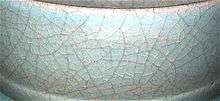
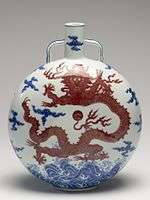
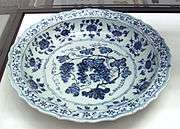
.jpg)